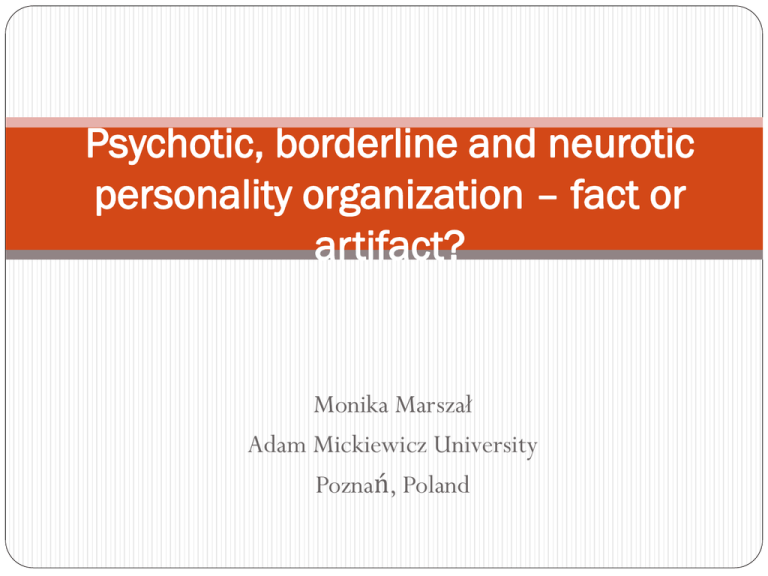Psychotic, borderline and neurotic personality organization
advertisement

Psychotic, borderline and neurotic personality organization – fact or artifact? Monika Marszał Adam Mickiewicz University Poznań, Poland Over the past few decades, object relation theories have become a central topic in conceptualization of personality disorders. One of them, Otto Kernberg’s theory is considered to be the most interesting, but also the most controversial one. When we are analyzing the psychodynamic literature it is hard not to claim that many of its assumptions should have been verified and described in an empirical way, based on well planned research. aim to recognize the etiology and describe the essence of intrapsychic structure, what is believed to be the source of a specific patterns of thinking, behaving and experiencing personality development … is based on an intrapsychic transformations of positive and negative self- object- affect representations. It can be inhibited as a consequence of a biological factor (ex. disharmonized temperament) and/or psychological factor connected with the lack of possibility to relate to the object (mother). If the fixation takes place in a symbiotic phase, we observe the psychotic PO when in a self/ object differentiation phase there’s borderline PO and when in a consolidation phase- neurotic PO structural model The differences between three levels of POs concerning 3 basic dimensions: 1. level of defense mechanisms maturity 2. level of identity integration 3. capacity to reality testing BPO is similar to PPO in case of domination of primitive defense mechanisms and identity disturbances but is different in case of reality testing, what makes it more similar to NPO. defense mechanisms BPO and PPO are constructed by the primitive defense mechanisms like: splitting, projection and projective identification. The maintenance of those mechanisms results in the lack of integration between libidinal and aggressive aspects of self and object. This integration is achieved in NPO, where splitting is replaced by the more mature mechanisms: repression, denial, reversal. identity In NPO we can observe high level of stability and continuity of self/object representations, what results in identity integration. In PPO and BPO identity is diffused, unstable, or connected with foreclosure identity (Kernberg, 2004, 2004, 1970, 1967). Reality testing A broad deficit in PPO, but individuals with BPO may present some disturbances as well. In general, we can assume that reality testing is seriously impaired only in PPO, when patients suffer from hallucinations, delusions, and confusion about their own existence (Kernberg, 2004b, 1970, 1967; McWilliams, 2009). Reality testing is not disturbed in NPO. Aim of the study Concerning this brief theoretical description, in our research we decided to empirically verify the assumptions about the differences in capacity to reality testing, level of identity integration and predominance of certain defense mechanisms in neurotic, borderline and psychotic PO. Participants 90 individuals: 30 individuals with the BPO, 30 individuals with the PPO and 30 individuals with the NPO. The criteria of selection to the groups were psychiatric and/or psychological evaluation. 18 -64 years old (M=32.9), 46 women and 44 men. 70% of the participants had high school degree, 24.5% of the participants had college/university degree and 5.5% had elementary school degree. Among the participants with the BPO and NPO there were more women than men, but in the case of the participants with the PPO there were considerably more men. Methods Defense Mechanisms Inventory (1969) by C. Gleser and D. Ihilevich. Objective Measure of Ego-Identity Status Bennion i Adams (1986). Ego Strength (Es) F. Barron from MMPI (Barron, 1953). Results Ego strength post hoc T3 Dunnet NPO Ego strength F(2,85)= 16,057; P< .001 48,1 BPO 41,4 PPO 36,4 Only patients with NPO are characterized by undisturbed reality testing, what means that there are no situations when they have problems with self/ other, inner/ outer differentiation. PPO is the most disturbed, in BPO problems probably can appear in times of regression (ex. due to severe stress) Defence mechanisms Turning against object Pojection Turning against self P Reversal Test Kruskala- Wallisa Test U Manna- Whitneya 61,22 χ2 (2)= 25,974; P< .001 BPO PPO NPO BPO PPO NPO NPO BPO PPO 57,6 46,68 NPO PPO BPO PPO NPO BPO 60,57 χ2 (2)= 20,322; P< .001 χ2 (2)= 10,590; P< .05 χ2 (2)= 21,902; P< .001 χ2 (2)= 27,191; P< .001 36,08 30,55 28,35 55,12 39,74 34,63 40,25 30,48 58,16 51,98 25,30 in accordance with the previous assumptions Mature principalization used by neurotic individuals to a greater degree than by borderline and psychotic individuals (there has been no differences between those two groups) Primitive projection was used less frequently by neurotic individuals. The differences were statistically significant. In the case of this two subscales the assumption that mature defenses are more often used by the NPO individuals has been confirmed, with the simultaneous lack of differences between the PPO and the BPO groups. Mature reversal- borderline individuals obtained significantly lower scores than the PPO and NPO groups between which there were no differences (possible impact of social approval variable) (Dudley, 1978) Primitive turning against the object- borderline individuals obtained statistically significant higher scores in this scale than the two other groups Primitive turning against self- the most surprising results, significant differences were observed between the high NPO scores and the two other groups Identity Kruskala- Wallis test Achieved Moratorium Difussed Foreclosured χ2 (2)= 16,139; P< .001 χ2 (2)= 18,398; P< .001 χ2 (2)= 13,810; P< .001 χ2 (2)= 20,723; P< .001 U Mann- Whitney test PPO NPO BPO PPO BPO NPO PPO BPO NPO PPO NPO BPO 55,18 47,21 29,33 56,6 50,75 19,15 58,62 42,93 33,90 61,27 42,23 31,03 Diffused identity was used more frequently by individuals with PPO than any other organization Moratorium (currently experiencing an identity crisis) is observed significantly more frequent in PPO and BPO than NPO Foreclosured identity status is more frequently observed in PPO (seems to be consistent with the clinical characteristics of psychotic disorders, this identity status is described as a rather stable structure, but determined entirely by other people (parents) and not confirmed in an individual way) Achieved identity- higher performance of psychotic and neurotic patients in achieved identity status. As expected, the psychotic person should present lower results on the scale relating to an integrated identity, while a high score of the neurotic is consistent with the previous assumptions. To what extent does the organization of personality pathology can be explained by the variables in the model indicated by O. Kernberg? Logisic regression NEUROTIC BORDERLINE PSYCHOTIC Variable B SE Exp (B) Variable B SE Exp (B) Variable B SE Exp (B) TAO -0,70* ,03 ,93 Achieved Identity -,07* ,03 ,94 TAS -,15* ,06 ,87 TAS ,10* ,05 1,10 F Identity ,07** ,03 ,93 REV ,12** ,04 1,12 Ego Strength ,13** ,04 1,14 TAO ,14** ,04 1,16 Ego Strength -,12* ,05 ,89 Moratori um Identity ,09** ,03 ,91 Diffused Identity ,08* ,04 1,08 ** p < .01. * p < .05. Logistic regression neurotic personality organization is explained by the high score on reality testing (ego strength) and turning against self mechanism, and low scores on the moratorium identity status and aggression against the object. borderline personality organization is explained by the low scores on the achieved (A) and foreclosed (F) identity and high scores on agression against object scale. psychotic personality organization is explained by the high scores on reversal (REV) and identity diffusion (D) scale and low scores on reality testing and a turning against self. Conclusion On the basis of the study we can not clearly answer the question of whether proposed by Otto Kernberg personality characteristics of different PO is in line with reality.The results seem to be interesting, especially when we consider the qualitative differences between compared groups in the analyzed variables. It appears that testing on a larger group of subjects, using a more diverse and accurate methods could result in a more unambiguous results. Certainly, this study may serve as a good starting point for further research in this very interesting area. Sources American Psychiatric Association (2000). Diagnostic and statistical manual of mental disorders (4rt ed. rev.). Washington, DC: Author. Chabrol, H., & Leichsenring, F. (2006). Borderline personality organization and psychopathic traits in nonclinical adolescents: Relationships of identity diffusion, primitive defense mechanisms and reality testing with callousness and impulsivity traits. Bulletin of the Menninger Clinic, 70(2), 160–170. Gleser, G. C., Ihilevich, D. (1969). An objective instrument for measuring defense mechanisms. Journal of Consulting & Clinical Psychology, 33, 51-60. Kernberg, O.F. (1996). A psychoanalytic theory of personality disorders. W: J.F. Clarkin, M.F. Lenzenweger (red.), Major theories of personality disorders (s. 106-140). New York London: The Guilford Press Kernberg, O.F. (2004). Borderline personality disorder and borderline personality organization: Psychopathology and psychotherapy. W: J. J. Magnavita (red.). Handbook of personality disorders.Theory and practice. (s. 92-119). New Jersey: John Wiley & Sons, Inc. Kernberg, O.(1967). Bordeline personality organisation. Journal of the American Psychoanalytic Assosiation, 15, 641- 685 Leichsenring F, Kunst H, Hoyer J. (2003). Borderline personality organization in violent offenders: Correlations of identity diffusion and primitive defense mechanisms with antisocial features, neuroticism, and interpersonal problems. Bulletin of the Menninger Clinic 67(4):314-327 Leichsenring, F. (1999). Development and First Results of the Borderline Personality Inventory: a selfreport instrument for assessing Borderline Personality Organisation. Journal of Personality Assesstment, 73(1), 45- 63 Leichsenring, F. (1999). Splitting: an empirical study. Bulletin of the Menninger Clinic, vol. 63, No. 4 (Fall





![Crisis Communication[1] - NorthSky Nonprofit Network](http://s2.studylib.net/store/data/005428035_1-f9c5506cadfb4c60d93c8edcbd9d55bf-300x300.png)

